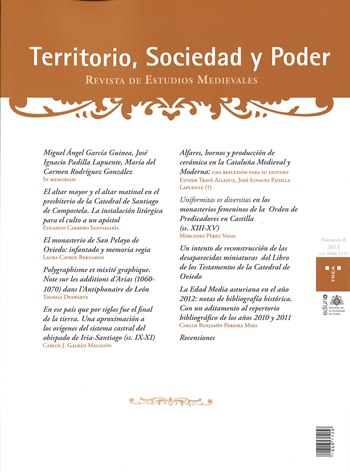Resumen
Resumen: Las fortalezas presentes en el entorno dela sede Santiago suelen analizarse como un conjuntohomogéneo diseñado para la defensa. Sin negar o afirmaresto, ha de tenerse en cuenta la temprana intervenciónde la monarquía en la configuración de un sistema defortificaciones en el occidente gallego y la peculiarinclusión del señorío de los prelados dentro del mismo.Así, se presta especial atención, primero, a los problemasintrínsecos para el estudio de fortificaciones en el áreade influencia de la sede de Iria, segundo, la acumulaciónde un grupo de fortificaciones dentro de un dominiocentralizado y, por último, a las posibles modalidades decontrol de las fortificaciones.Palabras clave: Castillos, fortalezas, sede Iria - Santiago,Galicia, Alta Edad Media.Abstract The fortresses around the See of Santiagohave been traditionally analyzed as a homogeneous groupdesigned for defense. In this way, the situation during thegolden years of Diego Gelmirez -with a very strong role ofthe church in the power contest between lords and kings-,has been the ideal model for interpreting the development ofcastles. This unfortunate comparison, although favored byGelmirez chroniclers, has produced the misinterpretation ofthe previous church castle building policies. Being the resultof, at least in theory, an precocious castle building policydesigned for the protection of Galicia, taken as a wholeterritory, from the menaces coming from the sea. Servingthus as a deterrence measure against Vikings and Saracens.Albeit this point of view, after a revision of the archaeologicaldata and documentary sources, some elements should beconsidered in a more holistic approach.First of all, the intrinsic matters and problems regardingcastle studies in the sphere of influence of the See of Iria. Theexistence of earlier fortifications with little or none referencesin contemporary sources, but proved by archaeology andlater documents, could not be neglected. This writtenvacuum would be more tied both to the progressive diffusionof new forms of organization of men and lands and tomedieval document conservation practices. Yet there existsmany questions regarding properly definition, chronologyand functions played by those early ‘castles’.Second, the early intervention of the Crown in theconfiguration of a network of fortresses in Western Galiciaand the unusual inclusion of the bishops’ lordship within,have to be considered. The delegation of some attributionsof royal power to laic lords and bishops must not beregarded as a symptom of chaos, but of strict and correctregulation of the Galician territory, even if incomplete.The political and territorial rise of the See of Iria is in goodmeasure a mean for spreading royal control over not sotrustable lords. From this perspective, the configuration of agroup of fortifications inside a centralized dominion is nota byproduct from the military royal policy or the initiativeof a particularly clever bishop is the main consequenceof a conscious and systematic strategy of land controland economic exploitation. As the origins of each castlebelonging to the See proves. So the growing complexity andthe creation of a system of dominion incorporating castlesshould be taken as a hint of the intimacy relations and tiesbetween church and kingship.Third, it has to be considered the ways of control andtenure of fortifications in the lands of the See. Despitethe paucity of data regarding such aspects, it has to behighlighted the role of individuals from the local nobility,as officers and bishops, for the proper rule of the dominion.Equally, episcopal elections have an special meaning for thekings, the possibility of controlling the political orientationof the See.Keywords: Castles, fortresses, Iria - Santiago, Galicia, HighMiddle Ages.Descargas
Los datos de descargas todavía no están disponibles.

